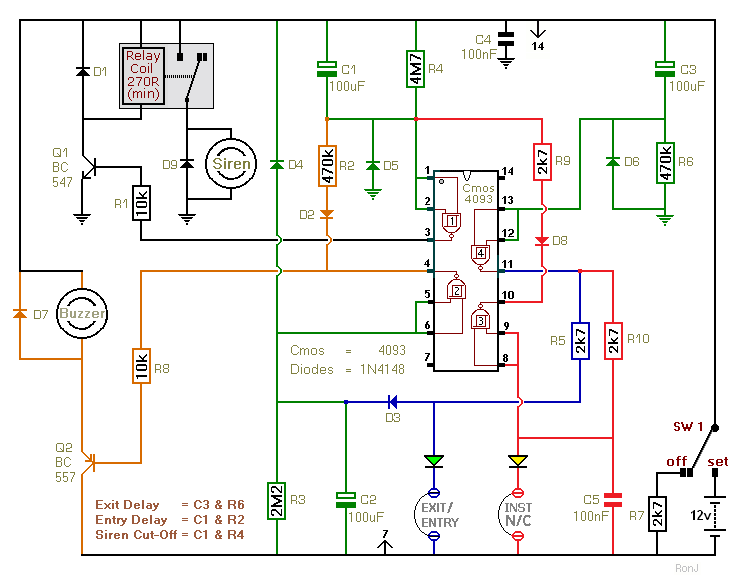
dub siren circuit

The objective of this project was to create a custom device utilizing local manufacturing resources. At that time, there was a pressing need for a Dub Siren. A circuit diagram was located, and with the assistance of an electronics engineer, a schematic was developed, which included additional design elements. Subsequently, approval was obtained from the Imperial College to produce four circuit boards. After assembling the circuit and conducting live testing, a box was constructed to house the device, featuring a transparent section to showcase the craftsmanship of the local manufacturers involved.
The project involved the design and fabrication of a Dub Siren, a device commonly used in music production and live performances to create unique sound effects. The initial step included sourcing a circuit diagram that outlines the essential components and connections necessary for the Dub Siren's functionality. This diagram served as the foundation for creating a detailed schematic, which was enhanced with graphical elements such as space invaders, adding a unique aesthetic appeal to the project.
Collaboration with an electronics engineer facilitated the refinement of the schematic, ensuring that all components were accurately represented and properly interconnected. The design likely included essential elements such as oscillators, filters, and amplifiers, which are critical for generating the distinctive sounds characteristic of a Dub Siren. The decision to involve local manufacturers for the production of the circuit boards not only supported the community but also ensured a hands-on approach to the manufacturing process.
Upon receiving the printed circuit boards from Imperial College, the assembly process commenced. This involved soldering various electronic components onto the boards, ensuring that each connection was secure and functional. Rigorous testing was performed during live concerts to validate the performance and reliability of the Dub Siren, allowing for real-time adjustments and improvements based on feedback from the audience and performers.
Finally, the construction of a custom enclosure for the Dub Siren was undertaken. The design featured a transparent window, providing visibility to the intricate work of the local manufacturers and showcasing the artistry involved in the creation of the electronic device. This not only served a practical purpose by protecting the internal components but also highlighted the collaborative effort that went into the project, celebrating local craftsmanship and innovation in electronics.The aim of this project was to have a bespoke object made using local manufacturing. At the time I was in dire need of a Dub Siren. I found a circuit diagram, with the help of an electronics engineer (Stephan), we drew a schematic, to which he added some space invaders. We then convinced the Imperial college to print 4 circuit boards for me. I ass embled the circuit and after some tesing (live in concert) I built a box for it, with a window so the handiwork of the two local manufacturers involved could be admired. 🔗 External reference
The project involved the design and fabrication of a Dub Siren, a device commonly used in music production and live performances to create unique sound effects. The initial step included sourcing a circuit diagram that outlines the essential components and connections necessary for the Dub Siren's functionality. This diagram served as the foundation for creating a detailed schematic, which was enhanced with graphical elements such as space invaders, adding a unique aesthetic appeal to the project.
Collaboration with an electronics engineer facilitated the refinement of the schematic, ensuring that all components were accurately represented and properly interconnected. The design likely included essential elements such as oscillators, filters, and amplifiers, which are critical for generating the distinctive sounds characteristic of a Dub Siren. The decision to involve local manufacturers for the production of the circuit boards not only supported the community but also ensured a hands-on approach to the manufacturing process.
Upon receiving the printed circuit boards from Imperial College, the assembly process commenced. This involved soldering various electronic components onto the boards, ensuring that each connection was secure and functional. Rigorous testing was performed during live concerts to validate the performance and reliability of the Dub Siren, allowing for real-time adjustments and improvements based on feedback from the audience and performers.
Finally, the construction of a custom enclosure for the Dub Siren was undertaken. The design featured a transparent window, providing visibility to the intricate work of the local manufacturers and showcasing the artistry involved in the creation of the electronic device. This not only served a practical purpose by protecting the internal components but also highlighted the collaborative effort that went into the project, celebrating local craftsmanship and innovation in electronics.The aim of this project was to have a bespoke object made using local manufacturing. At the time I was in dire need of a Dub Siren. I found a circuit diagram, with the help of an electronics engineer (Stephan), we drew a schematic, to which he added some space invaders. We then convinced the Imperial college to print 4 circuit boards for me. I ass embled the circuit and after some tesing (live in concert) I built a box for it, with a window so the handiwork of the two local manufacturers involved could be admired. 🔗 External reference





